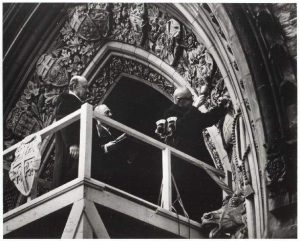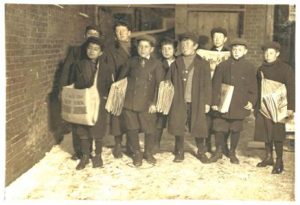Tartan Day in Newfoundland and Labrador

Credit: Barbara Griffin Art Collections https://pixels.com/profiles/barbara-griffin.html
Newfoundland Nostalgia
Tartan Day in Canada, April 6th, has become a yearly event. The concept of Tartan Day began at a meeting of the Federation of Scottish Clans in Nova Scotia on 09 March 1986.
Tartan day was chosen to promote Scottish Heritage by the most visible means. The wearing of the Scottish attire, especially in places where the kilt is not ordinarily worn, i.e.: work, play or worship.
Starting originally as ‘Tartan Day in Nova Scotia’, Jean Watson approached every provincial Legislative Assembly in Canada, as well as other Scottish-cultural societies across Canada, to help get such a date established.
After ten years of work, Tartan Day in Canada was approved in every Provincial Assembly from sea to sea by Premier’s proclamation or Members’ Bill. The Provincial Government of Newfoundland & Labrador officially adopted the Newfoundland tartan on 6 April 1995.
The official tartan of Newfoundland and Labrador
The official tartan of Newfoundland and Labrador was designed in 1955 by Samuel B. Wilansky, a local store owner on Water Street in St. John’s. It was registered in the Court of the Lord Lyon in 1973. The white, gold, and yellow come from the province’s official anthem, “Ode to Newfoundland”:
The green represents the pine forests, the white represents snow, the brown represents the Iron Isle, and the red represents the Royal Standard. Its International Tartan Index number is 1543.
The region of Labrador also has its own design of tartan created by Michael S. Martin. The tartan of Labrador, was inspired by the influence of Donald Smith. Scots migrated to Labrador in the 19th century to work for the Hudson’s Bay Company (HBC). Sir Donald Smith, (1836 – 1914) HBC’s chief trader for Labrador in 1852 and established the company’s headquarters at North West River. Smith lived at Labrador for 21 years before becoming Lord Strathcona in 1897. Smith became engaged in many other business and political ventures, including helping to make Canada one nation through the visionary plan of a railway system connecting the entire country. As the co-founder of the Canadian Pacific Railroad, Smith spearheaded the building of the trans-Canada railroad and drove the last spike in 1885. The Labrador tartan was sent to the Scottish Register of Tartans, which assigned reference number 10004 to the tartan. See: https://www.tartanregister.gov.uk/tartanDetails?ref=10004
“Some of the greatest builders of Empire in Terra Nova have been and are Scotsmen … “
The Scottish are no stranger to Newfoundland and Labrador, in fact it has been said that “Some of the greatest builders of Empire in Terra Nova have been and are Scotsmen … “ The evidence is persuasive. Some of the Scottish Merchant Firms in Newfoundland and Labrador include:
William Alexander, Bonavista
Baird Brothers, Saltcoats, Ayrshire St. John’s (1852) St. Andrew ‘s Society
Browning & Son, biscuit manufacturers, Ayrshire.
Baine, Johnston and Company, Port De Grave and St. John’s (1780)
Crawford and Company, St. John’s
Goodfellow & Company
Archibald Graham, Trinity
Walter Grieve and Company, St. John’s
Robert Hutton, St. John’s
Hunter and Company, St. John’s
John Munn and Company, Harbour Grace
Robert Templeton of Glenluce, Scotland in 1860.
H. Davidson, Aberdeen, (Messrs. J. & W. Stewart)
Sir Robert Thorburn was born at Juniper Bank, Peebleshire, 1852. Thorburn & Tessier.
Thomas McMurdo & Company,St. John’s the well-known drug firm, 1823
MacPherson at Port De Grave of Greenock
McBride & Kerr (Greenock)
McPherson , “The Royal Stores, St. John’s
The Reid Newfoundland Company Coupar Angus, Perthshire.
Messrs. Patrick and Andrew Tasker, St. John’s
Rennie Stewart & Company, St. John’s
William Frew, Saltcoats, Ayrshire, in 1881, Newfoundland Boot and Shoe Manufacturing Company.
John Syme, Irvine, Ayrshire, J. & W. Stewart,. Known as the “Dundee Co.”
James Stewart
The tartan they “richt weel” wore, and far across the foam,
Did foster the old traditions of the dear loved Highland home.
The land of Burns and Wallace is proud it gave them birth,
For all have played a noble part in proving Scotland’s worth
Wear your Newfoundland or Labrador tartan on Saturday, April 6th.
Recommended Reading: The tartan registry: https://www.tartanregister.gov.uk/tartanDetails?ref=3127
Recommended Archival Collection: The Rooms Archives is home to hundreds of photographs that feature individual and family photographs of Scottish heritage.












